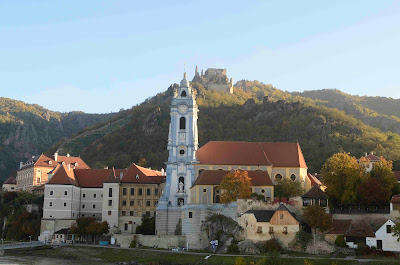We first docked at Durnstein, a medieval village whose centerpiece is a blue and white church that looks like it was shipped from Delft.
No traffic, except deliveries, is allowed in this town of 400. It was here that Richard the
Lionhearted was imprisoned and held until he was ransomed. This enchanting town reminded us of Carmel, CA transported back several hundred years. It is a tourist town of nice hotels and tempting shops, just the place for a long romantic weekend.
Our walking tour of the single street took us passed shops selling merillen.
We know merillen as apricot, but this one surpasses ours when made into jams, wines and liqueurs. We felt obligated to forego the climb to the monastery and sample some of this unique product.
Our cruise continued through the Wachau Valley, so lovely pictures may not do it justice.

Jerry and Anna Lee are considering bringing the motorhome to travel along the Danube. We have seen quite a few trailers and Class Cs and found a number of campgrounds equipped with power and water.
In the afternoon we docked at Melk for a visit to Stiftmelk, a wonderfully restored Benedictine Monastery. It was originally built in 1089 but restored in the mid 20th century so that some of the artistic elements are quite modern. Among its early sponsors were the Hapsburgs who had a marble hall for royal events. Thirty-three monks live and work within the 500 room, 40,000 square meter complex.

The rooms are ornately decorated with gilded wood and many pieces of art, both new and ancient. One of the prized possessions is a wooden crucifix over 900 years old.
Each room has a “message” from the teachings of St. Benedict. The lesson is presented by the use of colored lighting, the collection of religious items, the display of relics or an audio reading of his rules.
The exception to the display of riches occurred in the late 18th century when a more frugal emperor encouraged the use of less expensive materials and rituals (coffins that could be reused). He focused the budget of the church on the building of schools and aiding the needy.
The library is a research facility and has twelve rooms filled with 100,000 texts.
All this pales to the church filled floor to ceiling with heavily gilded alters, statues and columns.
We toasted this lovely day with a wine tasting of local wines grown by an Australian. The vineyards here are very small, one acre and less. The vines are planted horizontally on steep slopes and require hand picking.






No comments:
Post a Comment